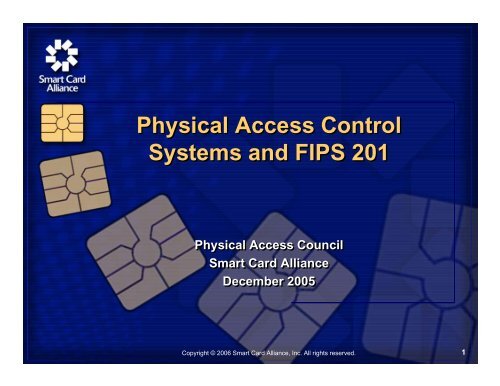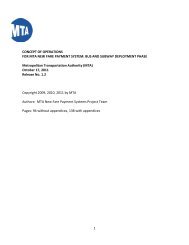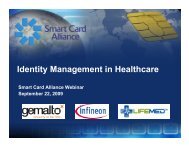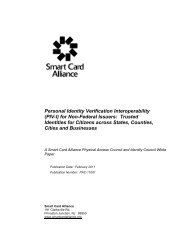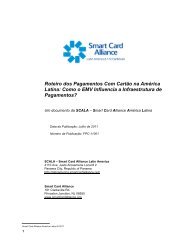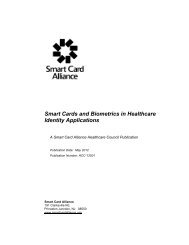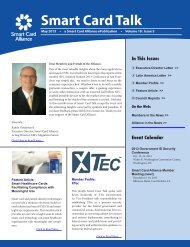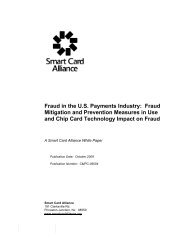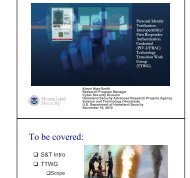Physical Access Control Systems and FIPS 201 Physical Access ...
Physical Access Control Systems and FIPS 201 Physical Access ...
Physical Access Control Systems and FIPS 201 Physical Access ...
You also want an ePaper? Increase the reach of your titles
YUMPU automatically turns print PDFs into web optimized ePapers that Google loves.
<strong>Physical</strong> <strong>Access</strong> <strong>Control</strong><br />
<strong>Systems</strong> <strong>and</strong> <strong>FIPS</strong> <strong>201</strong><br />
<strong>Physical</strong> <strong>Access</strong> Council<br />
Smart Card Alliance<br />
December 2005<br />
Copyright © 2006 Smart Card Alliance, Inc. All rights reserved.<br />
1
Topics<br />
Introduction: PACS Overview<br />
PIV Card PACS-Related Components<br />
PACS Readers<br />
PACS Panels & Hosts (Servers)<br />
PACS Infrastructure (Cabling, Communications<br />
<strong>and</strong> Interfaces)<br />
PACS & Biometrics<br />
Privilege Granting & Revocation<br />
PACS Certification & Accreditation<br />
Conclusions<br />
2
Introduction: Traditional PACS<br />
<br />
<br />
<br />
<br />
System operator verifies an employee’s identity according to<br />
organizational policy<br />
User credential is created <strong>and</strong> enrolled at PACS enrollment station<br />
Credential data <strong>and</strong> access privileges are downloaded to controllers<br />
database<br />
Readers at control points read data from credential <strong>and</strong> send data to<br />
controller for access decision<br />
3
1<br />
Employee<br />
Enrolls<br />
Introduction:<br />
PIV Identity Verification <strong>and</strong> Issuance<br />
2<br />
Employer/<br />
Sponsorship<br />
Employee<br />
Application<br />
5<br />
3<br />
Approval<br />
Authority<br />
Identity<br />
Management<br />
System (IDMS)<br />
6<br />
Identity Verification<br />
‣1:n<br />
‣1:n<br />
biometric<br />
biometric<br />
search<br />
search<br />
‣Confirm<br />
‣Confirm<br />
employment<br />
employment<br />
‣ID<br />
‣ID<br />
validation<br />
validation<br />
through<br />
through<br />
st<strong>and</strong>ard<br />
st<strong>and</strong>ard<br />
government-wide<br />
government-wide<br />
services<br />
services<br />
(HSPD-11)<br />
(HSPD-11)<br />
‣Government<br />
‣Government<br />
databases<br />
databases<br />
‣Threat<br />
‣Threat<br />
risk<br />
risk<br />
4<br />
Enrollment<br />
8<br />
7<br />
Card Production &<br />
Personalization<br />
PKI Infrastructure<br />
Issuer -<br />
Card Activation<br />
PIV Activated for<br />
Operational Use<br />
4
Introduction: <strong>FIPS</strong> <strong>201</strong> – PACS<br />
Relationship<br />
ID Records<br />
Personnel<br />
Data<br />
Card Management<br />
System<br />
Certificate<br />
Authority<br />
Bridge-Certified CA<br />
Identity<br />
Management<br />
System (IDMS)<br />
Employee<br />
<br />
<br />
<br />
<br />
<br />
<br />
<br />
A PIV cardholder arrives<br />
OCSP (or other means) confirms with IDMS<br />
that credential is still valid<br />
Enrollment officer confirms ID with PIV <strong>and</strong><br />
biometrics<br />
Enrollment officer confirms access<br />
requirements<br />
PACS enrollment officer adds PIV card CHUID<br />
to PACS<br />
PACS enrollment officer registers physical<br />
access privileges to PACS<br />
<br />
Uses low or medium assurance profile<br />
PACS performs periodic validity checks with<br />
IDMS<br />
5
<strong>Physical</strong> <strong>Access</strong> <strong>Control</strong><br />
<strong>Systems</strong> <strong>and</strong> <strong>FIPS</strong> <strong>201</strong>:<br />
PIV Card Components<br />
<strong>Physical</strong> <strong>Access</strong> Council<br />
Smart Card Alliance<br />
6
PIV Card Issues/Recommendations<br />
FASC-N Usage Requirements – How many of the<br />
FASC-N BCD digits (14 up to 32) need to be<br />
read/processed to be considered <strong>FIPS</strong> <strong>201</strong><br />
compliant?<br />
Since PACS v2.2/2.3 states that a minimum of the first 14 BCD digits<br />
(Agency Code, System Code, <strong>and</strong> Credential Number) need to be used<br />
to ensure a unique number across the Federal Government, this should<br />
be the minimum required for <strong>FIPS</strong> <strong>201</strong> compliance.<br />
GUID Usage Requirements – Cannot currently be<br />
relied on to be a unique number across the<br />
Federal Government.<br />
Guidance should be provided to PIV Issuers on using unique IPv6<br />
addresses for the GUID.<br />
Since there is no currently established st<strong>and</strong>ard for assigning a GUID<br />
<strong>and</strong> its uniqueness cannot be ensured, it should only be used locally.<br />
7
PIV Card Issues/Recommendations<br />
GUID Usage Requirements – What is the timeframe<br />
for implementing this?<br />
Since OMB policy has set June 2008 as the date by which all agencies’<br />
infrastructure (network backbones) must be using IPv6 <strong>and</strong> agency<br />
networks must interface with this infrastructure, this should be the target<br />
implementation date.<br />
Work should begin as early as possible to meet this target implementation<br />
date.<br />
Expiration Date Usage Requirements – When<br />
<strong>and</strong>/or how often does this need to be checked?<br />
The PIV card contains multiple expiration dates (e.g., printed on the PIV<br />
card, inside CHUID, printed info buffer (optional), within PKI certificates).<br />
Expiration dates need to be synchronized.<br />
This should initially only need to be checked/validated at the time of initial<br />
registration <strong>and</strong> not at each access control event.<br />
8
PIV Card Issues/Recommendations<br />
CHUID Asymmetric Signature Usage<br />
Requirements - When <strong>and</strong>/or how often does this<br />
need to be checked?<br />
The CHUID asymmetric signature should initially only need to be<br />
checked/validated at the time of initial registration <strong>and</strong> not at each<br />
access control event.<br />
At some later time this could be exp<strong>and</strong>ed as infrastructure matures.<br />
Card Authentication Key Usage Requirements -<br />
When <strong>and</strong>/or how should asymmetric keys be<br />
used in PACS?<br />
PACS 2.2/2.3 includes the use of symmetric keys for PACS in the high<br />
assurance profile, but does not include the use of asymmetric keys<br />
mentioned in <strong>FIPS</strong> <strong>201</strong> <strong>and</strong> SP 800-73.<br />
To ensure interoperability, this needs to be made m<strong>and</strong>atory <strong>and</strong> the<br />
PACS document must be updated to include this as a PKI high<br />
assurance profile.<br />
9
PKI High Assurance Profile:<br />
Strong, St<strong>and</strong>ards-based<br />
Token Authentication<br />
<strong>Physical</strong> <strong>Access</strong> Council<br />
Smart Card Alliance<br />
10
Recommendation <strong>and</strong> Benefits to<br />
Use Certificates for Authentication<br />
Uses industry st<strong>and</strong>ard <strong>and</strong> <strong>FIPS</strong> <strong>201</strong> compliant<br />
authentication methods with x.509 certificates (Card<br />
Authentication Certificate)<br />
Uses asymmetric authentication that is already required<br />
to read CHUID signature (no additional requirements for<br />
reader functionality)<br />
Provides acceptable physical access performance with<br />
dual-interface credentials<br />
Card Authentication Certificate does not require use of<br />
PIN for high throughput physical access applications<br />
Provides common solution across Federal agencies<br />
Eliminates key management issues with Shared Secret<br />
Keys<br />
11
Current PACS 2.2/2.3 Authentication<br />
Profiles<br />
CHUID Low Assurance<br />
Free read data, sent to panel<br />
Small volume of data<br />
Low anti-counterfeiting, low anti-tampering<br />
CHUID Medium Assurance<br />
Free read data, subset sent to panel<br />
Medium volume of signed data<br />
Low to medium (with security guard observation) anti-counterfeiting, higher antitampering<br />
CHUID High Assurance<br />
Authentication key stored on card<br />
Key verified by readers/panels holding Site Secret Key (SSK)<br />
Can’t use on a reader without a copy of an SSK<br />
Compromise of an SSK could permit batch counterfeiting<br />
SSK distribution/management challenges<br />
12
PKI High Assurance Profile<br />
On-card generation of private key (RSA, ECC)<br />
Public key bound to card/FASC-N in X.509<br />
certificate<br />
St<strong>and</strong>ard card authentication certificate from SP<br />
800-73, certificate profile from FICC<br />
Card verification without shared secrets (no SSK)<br />
Highest anti-counterfeiting<br />
Interoperation with logical security uses<br />
13
PKI High Assurance Notes<br />
PKI-capable cards required (e.g., current dualinterface<br />
cards)<br />
Readers (or bi-directional panels) with real<br />
time clock <strong>and</strong> RSA/ECC signature verification<br />
required to use certificates (i.e., same level<br />
required for CHUID verification in medium<br />
profile)<br />
No on-card second factors (PIN, biometric)<br />
required for contactless use. Second/third<br />
factors would require use of contact interface<br />
(on-card) or panel-side match (i.e., same as the<br />
other profiles)<br />
14
<strong>Physical</strong> <strong>Access</strong> <strong>Control</strong><br />
<strong>Systems</strong> <strong>and</strong> <strong>FIPS</strong> <strong>201</strong>:<br />
PACS Readers<br />
<strong>Physical</strong> <strong>Access</strong> Council<br />
Smart Card Alliance<br />
15
PACS Readers: <strong>FIPS</strong> <strong>201</strong><br />
Requirements<br />
<br />
<br />
<br />
<br />
<br />
<strong>FIPS</strong> <strong>201</strong> defaults to PACS 2.2 for access control – low, medium <strong>and</strong><br />
high assurance profiles.<br />
There is not a requirement to read <strong>and</strong> output the entire CHUID to open<br />
a door.<br />
Reading the entire CHUID would add more time to the actual transaction <strong>and</strong><br />
could not all be processed by modern day access control systems.<br />
Enough information should be read to output either the FASC-N or the<br />
GUID <strong>and</strong> to be able to calculate the HMAC for a higher level of<br />
assurance. If the highest assurance security level is required, the<br />
reader will also need to be capable of symmetric or asymmetric<br />
keying. Another option would be passing the card certificate from the<br />
contact chip.<br />
Whether ISO 14443 is used for contactless or ISO 7816 is used for<br />
contact chips, output to the access control panels should remain the<br />
same since the same CHUID data is used through either interface.<br />
Read speed is not believed to be an issue if the system is only reading<br />
<strong>and</strong> outputting the FASC-N/GUID alone or with the HMAC. Read speed<br />
may be an issue with reading/verifying very large biometric images or<br />
meeting higher security assurance profiles.<br />
16
PACS Readers:<br />
Issues/Recommendations<br />
<strong>FIPS</strong> <strong>201</strong> defaults to PACS2.2 for access<br />
control, low, medium <strong>and</strong> high assurance<br />
profiles.<br />
NIST should consider updating <strong>FIPS</strong> <strong>201</strong> to reference PACS<br />
2.3 or latest update.<br />
Readers can be configured to output many<br />
different configurations to the panel. The data<br />
that is output will be dependent on whether the<br />
agency is working with a legacy installation or<br />
new installation.<br />
For legacy installations, each access control vendor’s system is<br />
different <strong>and</strong> may initially require different data imported from<br />
the reader.<br />
For new installations, a minimum set of data to be passed from<br />
the FASC-N or GUID should be specified (e.g., 16 GUID digits).<br />
17
PACS Readers:<br />
Issues/Recommendations<br />
There has been no clear guidance from NIST or<br />
any government agency or committee on<br />
whether an access control card reader needs<br />
to go through conformance testing.<br />
There is an absolute need for NIST or some<br />
governing agency to publish a test data model<br />
set for an entire CHUID.<br />
Without an official data model set to test with, no reader vendor<br />
can truly build <strong>and</strong> test products to meet the SP800-73 "End<br />
Point" solution. This is an absolute must for the industry to<br />
deliver product in a timely manner.<br />
18
<strong>Physical</strong> <strong>Access</strong> <strong>Control</strong><br />
<strong>Systems</strong> <strong>and</strong> <strong>FIPS</strong> <strong>201</strong>:<br />
PACS Panels <strong>and</strong> Hosts<br />
(Servers)<br />
<strong>Physical</strong> <strong>Access</strong> Council<br />
Smart Card Alliance<br />
19
PACS Panels & Hosts: Overview<br />
<strong>FIPS</strong> <strong>201</strong> does not specify requirements related<br />
to the physical access control system.<br />
Implementation is manufacturer specific.<br />
Interoperability between PACS is not part of <strong>FIPS</strong> <strong>and</strong> therefore<br />
still open to interpretation by individual agencies.<br />
There is a lack of formal protocol or<br />
st<strong>and</strong>ardization for the interface between<br />
PACS <strong>and</strong> IDMS.<br />
Industry should define the interoperability st<strong>and</strong>ard to support<br />
<strong>FIPS</strong> <strong>201</strong> functionality.<br />
20
PACS Panels: Overview<br />
Panels are configured by head-end (host), but can work<br />
st<strong>and</strong>alone in offline mode to control door access. High<br />
throughput is required (e.g., turnstiles at start of shift).<br />
Cardholders are identified by matching card data from<br />
readers to cardholder data in panel database.<br />
Additional checks can be made on expiration date<br />
(either from card or from head end) <strong>and</strong> PIN.<br />
Connection to readers: Readers are connected to panel<br />
via Wieg<strong>and</strong>, RS-232/422/485, or other wired interface.<br />
Connection to head-end<br />
Card holder record including FASC-N fields or GUID, PACS expiration<br />
date, PIN, clearances<br />
21
PACS Panels & Reader Data<br />
There is a need to specify what data to use: FASC-N<br />
data or the full GUID. There are multiple data formats<br />
supported by the various reader vendors (e.g., 200-bit,<br />
128-bit, 64-bit, 40-bit)<br />
For full interoperability across agencies, the reader FASC-N<br />
data should minimally include the following (14 digits)<br />
• Agency (4 digits)<br />
• System (4 digits)<br />
• Credential (6 digits)<br />
For legacy applications, a fewer number of digits can be output,<br />
but the number will not be unique across Federal agencies <strong>and</strong><br />
must be assessed for risk by local security manager.<br />
Optionally, for medium security applications, the reader can<br />
also output a Hashed Message Authentication Code (HMAC)<br />
which is used to verify that the card has not been modified<br />
since cardholder enrollment into the PACS<br />
Optionally, the reader can also output the card’s expiration date<br />
22
PACS Hosts (Servers): Overview<br />
The PACS host is the primary application for<br />
configuring, controlling, <strong>and</strong> disseminating information<br />
about the access infrastructure (particularly controlled<br />
doors) <strong>and</strong> the cardholders who have access privileges<br />
to those doors. The host has a configuration database,<br />
a cardholder database, administrative functions for<br />
configuring doors, readers, panels, clearances,<br />
schedules, cardholders, <strong>and</strong> other various features. All<br />
configuration activity is journaled for audit purposes.<br />
The host communicates to administrative clients,<br />
guard/monitoring station clients, <strong>and</strong> panels<br />
The host interfaces to the IDMS <strong>and</strong> other enrollment<br />
systems.<br />
23
PACS Hosts: Cardholder Database<br />
Name<br />
Privileges<br />
Clearances<br />
Card number data<br />
FASC-N data fields <strong>and</strong>/or GUID<br />
HMAC for medium security<br />
Other user-defined fields<br />
Expiration date<br />
Picture (This does not have to be in the<br />
database, but can be the path of a picture file.)<br />
24
PACS Hosts: Cardholder Enrollment<br />
Enrollment GUI in the admin client allows data<br />
to be entered manually.<br />
Methods to interface to other applications<br />
IDMS used to issue the badge<br />
Local enrollment application where cardholders present their<br />
badges the first time they access the facility. A reader would<br />
read the card <strong>and</strong> populate the cardholder database with the<br />
data encoded on the card.<br />
A revocation list monitoring application can un-enroll a<br />
cardholder who appears on the revocation list.<br />
25
<strong>Physical</strong> <strong>Access</strong> <strong>Control</strong><br />
<strong>Systems</strong> <strong>and</strong> <strong>FIPS</strong> <strong>201</strong>:<br />
PACS Infrastructure<br />
(Cabling, Communications &<br />
Interfaces)<br />
<strong>Physical</strong> <strong>Access</strong> Council<br />
Smart Card Alliance<br />
26
PACS Infrastructure: Issues /<br />
Recommendations<br />
C CR CRI<br />
CARD<br />
1 2 3 4 4<br />
CARD<br />
READER<br />
CARD<br />
READER<br />
INTERFACE<br />
Interface Points 1,2,3:<br />
Could be combined<br />
ACP<br />
Local<br />
Database<br />
ACCESS<br />
CONTROL<br />
PANEL<br />
LAN/WAN<br />
ADMIN or CLIENT<br />
WORKSTATION<br />
Relevant Issue: <strong>FIPS</strong> compliance does not imply PACS compliance <strong>and</strong><br />
therefore confusion will result ; “what is compliance?”<br />
Recommendation: Minimum specifications for reader output should be<br />
more clearly defined based on open st<strong>and</strong>ards<br />
Relevant Issue: One way or two way reader communications with ACP<br />
Recommendation: Two way communications with readers are possible<br />
(<strong>and</strong> now also with Weig<strong>and</strong> data) <strong>and</strong> more secure<br />
but not addressed. Tools to crack Weig<strong>and</strong> available.<br />
Relevant Issue: Intelligent readers do not prevent physical attacks<br />
Recommendation: Employ tamper mechanisms to avoid physical attacks<br />
<strong>and</strong> provide guidance on door <strong>and</strong> hardware specs for<br />
high assurance applications<br />
5<br />
LAN/WAN<br />
IDMS<br />
PACS Server/<br />
Database<br />
27
PACS Infrastructure: Issues /<br />
Recommendations<br />
C CR CRI<br />
CARD<br />
1 2 3 4 4<br />
CARD<br />
READER<br />
Interface Point 2<br />
Could be combined<br />
CARD<br />
READER<br />
INTERFACE<br />
ACP<br />
Local<br />
Database<br />
ACCESS<br />
CONTROL<br />
PANEL<br />
LAN/WAN<br />
ADMIN or CLIENT<br />
WORKSTATION<br />
Relevant Issue: No established definition of a <strong>FIPS</strong> reader<br />
Recommendation: Provide fundamental interface requirements to<br />
permit minimum (open st<strong>and</strong>ards based) criteria for<br />
establishing basic output specs for compliant readers<br />
Relevant Issue: Degree or level of compatibility of <strong>FIPS</strong> compliant<br />
readers is not defined. How compatible is it?<br />
Recommendation: Establish levels of compatibility <strong>and</strong> compliance which<br />
are commensurate with the communications<br />
requirements to achieve low, medium <strong>and</strong> high<br />
assurance profiles; include guidance on one-way or<br />
two-way communications if necessary to comply with<br />
high assurance <strong>and</strong> PKI applications<br />
5<br />
LAN/WAN<br />
IDMS<br />
PACS Server/<br />
Database<br />
28
PACS Infrastructure: Issues /<br />
Recommendations<br />
C CR CRI<br />
CARD<br />
CARD<br />
READER<br />
Could be combined<br />
1 2 3 4 4<br />
CARD<br />
READER<br />
INTERFACE<br />
Interface Point 2 cont’d<br />
ACP<br />
Local<br />
Database<br />
ACCESS<br />
CONTROL<br />
PANEL<br />
LAN/WAN<br />
ADMIN or CLIENT<br />
WORKSTATION<br />
Relevant Issue: No established minimum outputs for compatibility<br />
with legacy systems<br />
Recommendation: Establish minimum default settings for legacy systems<br />
(based on st<strong>and</strong>ards) as well as minimum outputs to<br />
meet minimum future GUID requirements<br />
5<br />
LAN/WAN<br />
PACS Server/<br />
Database<br />
IDMS<br />
29
PACS Infrastructure: Issues /<br />
Recommendations<br />
C CR CRI<br />
CARD<br />
1 2 3 4 4<br />
CARD<br />
READER<br />
Interface Point 3<br />
Could be combined<br />
CARD<br />
READER<br />
INTERFACE<br />
ACP<br />
Local<br />
Database<br />
ACCESS<br />
CONTROL<br />
PANEL<br />
LAN/WAN<br />
ADMIN or CLIENT<br />
WORKSTATION<br />
Relevant Issue: Lack of security between reader <strong>and</strong> panel provides a<br />
weak link for PACS. RS232, RS485 & current loop are<br />
established asynchronous bi-directional forms of<br />
communications st<strong>and</strong>ards <strong>and</strong> can be made secure<br />
but are not addressed in any current guideline documents<br />
Recommendation: Consider encryption for medium <strong>and</strong>/or high<br />
assurance applications<br />
Relevant Issue: Card reader interface to ACP is typically proprietary<br />
Recommendation: Emphasis should be on CRI to card reader for open<br />
st<strong>and</strong>ards <strong>and</strong> minimum data requirements set for<br />
legacy systems <strong>and</strong> with migration guidelines for<br />
future proofing such as requirements for the GUID<br />
5<br />
LAN/WAN<br />
IDMS<br />
PACS Server/<br />
Database<br />
30
C CR CRI<br />
CARD<br />
1 2<br />
CARD<br />
READER<br />
PACS Infrastructure: Issues /<br />
Recommendations<br />
CARD<br />
READER<br />
INTERFACE<br />
Interface Point 4/5<br />
Could be combined<br />
3<br />
ACP<br />
Local<br />
Database<br />
ACCESS<br />
CONTROL<br />
PANEL<br />
4 4<br />
LAN/WAN<br />
ADMIN or CLIENT<br />
WORKSTATION<br />
5<br />
LAN/WAN<br />
PACS Server/<br />
Database<br />
Relevant Issue: Data fields within the schema of the PACS database<br />
server are not identified <strong>and</strong> may not correlate to those<br />
in the CHUID fields for easy migration to the host from<br />
the IDMS. Every system will therefore have to be<br />
customized at a cost<br />
Recommendation: Establish a minimum set of data to be imported <strong>and</strong><br />
the method of transfer for st<strong>and</strong>ardization<br />
(for example, XML). All systems would have same set<br />
Relevant Issue: There is much confusion on what is open <strong>and</strong> what is<br />
IDMS<br />
proprietary when PACS systems are evaluated <strong>and</strong><br />
purchases are made on beliefs <strong>and</strong> assumptions<br />
Recommendation: Clearly define what portions of the PACS are to be<br />
based on open st<strong>and</strong>ards <strong>and</strong> what does not have to be 31
<strong>Physical</strong> <strong>Access</strong> <strong>Control</strong><br />
<strong>Systems</strong> <strong>and</strong> <strong>FIPS</strong> <strong>201</strong>:<br />
Biometrics<br />
Smart Card Alliance<br />
<strong>Physical</strong> <strong>Access</strong> Council<br />
32
Biometrics<br />
An access control reader with biometric capability is<br />
required for assurance levels of high confidence or<br />
very high confidence<br />
NIST Special Publication 800-76 provides<br />
interoperable biometric data specification for<br />
storage on the PIV card<br />
Requires storage of minutiae templates from two index fingerprints<br />
• Templates must comply with ANSI-INCITS 378 st<strong>and</strong>ard<br />
• Alternative fingers are allowed if index fingers cannot be imaged<br />
SP 800-76 is in draft mode <strong>and</strong> is still subject to change<br />
33
Biometrics:<br />
Issues/Recommendations<br />
Use of contact readers <strong>and</strong> PIN entry for release of the<br />
m<strong>and</strong>atory fingerprint templates may not be appropriate<br />
for PACS due to throughput performance requirements<br />
or environmental requirements<br />
Use of alternative biometric paradigms for contactless<br />
operation is not precluded in <strong>FIPS</strong> <strong>201</strong><br />
However, such implementations may not be interoperable with other<br />
agencies<br />
Examples of alternative biometric paradigms include:<br />
Different modalities (e.g., fingerprint, iris, face, h<strong>and</strong> geometry, etc.)<br />
Store on card – match on reader (agency specific PIV container)<br />
Store on server – match on server (CHUID acts as pointer to biometric<br />
record in external database)<br />
Store on card – match on card (PIN replacement option)<br />
34
Biometrics:<br />
Issues/Recommendations<br />
If fingerprint templates are used for alternative<br />
authentication paradigms, they should comply<br />
with the INCITS 378 st<strong>and</strong>ard (as defined in SP<br />
800-76) to allow interoperability with various<br />
manufacturer’s hardware sensors <strong>and</strong><br />
algorithms that may be used within an agency<br />
If biometric templates are stored off the PIV<br />
card, consider the requirement for an external<br />
communications link from PACS reader<br />
PIN entry or contact reader is not required if an<br />
alternative biometric paradigm is chosen<br />
35
<strong>Physical</strong> <strong>Access</strong> <strong>Control</strong><br />
<strong>Systems</strong> <strong>and</strong> <strong>FIPS</strong> <strong>201</strong>:<br />
Privilege Granting <strong>and</strong><br />
Revocation<br />
<strong>Physical</strong> <strong>Access</strong> Council<br />
Smart Card Alliance<br />
36
Privilege Granting <strong>and</strong> Revocation<br />
PACS privileges (authorizations) for PIV<br />
cardholders are granted <strong>and</strong> revoked based on<br />
local security policies.<br />
The biggest issue related to granting privileges is trust in the<br />
PIV cardholder’s identity.<br />
This trust can be established at varying levels of assurance<br />
through the <strong>FIPS</strong> <strong>201</strong> PIV authentication mechanisms.<br />
Asymmetric key related authentication mechanisms require<br />
network connectivity to CRLs <strong>and</strong>/or OCSP responders.<br />
Continued trust in the PIV card requires that the issuing agency<br />
support the card’s validity by distributing or providing access to<br />
pertinent status change information.<br />
37
Privilege Granting <strong>and</strong> Revocation<br />
PACS revocation pertains to the revocation of<br />
privileges <strong>and</strong> not the revocation of a PIV card.<br />
PACS privileges can be revoked even though the PIV card has<br />
not been revoked, but PACS privileges should be revoked if the<br />
PIV card (PIV authentication certificate) is revoked.<br />
Automated PACS privilege revocation for revoked PIV cards is<br />
not m<strong>and</strong>atory, but is recommended.<br />
Automated PACS privilege revocation based on a revoked PIV<br />
authentication certificate requires network connectivity to the<br />
PKI infrastructure (e.g., CRLs <strong>and</strong>/or OCSP responders).<br />
There is no requirement that each access point triggers a<br />
credential status request, as long as the PACS is updated<br />
according to agency-specific <strong>FIPS</strong> <strong>201</strong>-compliant procedures.<br />
38
Privilege Granting <strong>and</strong> Revocation<br />
System processes that update <strong>and</strong> synchronize<br />
PIV card status in affected PACS databases are<br />
essential.<br />
In addition to CRLs <strong>and</strong> OCSP responses, a PIV card hotlist<br />
could be maintained on some or all revoked or terminated PIV<br />
cards. This hotlist could be made accessible online or could be<br />
distributed on a scheduled basis (e.g., hourly, daily).<br />
For added security, the hotlist could be digitally signed by its<br />
issuer/maintainer.<br />
<strong>FIPS</strong> <strong>201</strong> m<strong>and</strong>ates a maximum 18 hour update of CRLs, which<br />
should be the maximum update time for the hotlist.<br />
In cases where 18 hours is an unacceptable delay, alternate<br />
procedures must be implemented to disseminate this<br />
information within a shorter <strong>and</strong> acceptable timeframe.<br />
39
<strong>Physical</strong> <strong>Access</strong> <strong>Control</strong><br />
<strong>Systems</strong> <strong>and</strong> <strong>FIPS</strong> <strong>201</strong>:<br />
Certification & Accreditation<br />
<strong>Physical</strong> <strong>Access</strong> Council<br />
Smart Card Alliance<br />
40
PACS Products Issues<br />
GSA has not published a methodology for PACS<br />
equipment to be on its approved product list.<br />
It is recommended that GSA only certify the PACS readers.<br />
The PACS system vendors need GSA-approved transitional <strong>and</strong> endstate<br />
smart card samples encoded with the finalized data model to do<br />
system development <strong>and</strong> testing.<br />
Contactless reader approval process need to conform to the current<br />
ISO/IEC 14443 st<strong>and</strong>ard.<br />
Industry (e.g., SIA, NFPA, UL) needs to define<br />
interoperability st<strong>and</strong>ards to support <strong>FIPS</strong> <strong>201</strong> <strong>and</strong> other<br />
functionality<br />
Communications security: reader-panel, panel-panel, panel-host, hosthost<br />
Interoperability: Host-host communication, ODBC, XML, common<br />
database format (issuer authentication, camera call up, visitor<br />
management systems)<br />
41
Facility Security Guidance<br />
There is no defined guidance to inform agencies about<br />
what level of equipment should be purchased<br />
Equipment selection criteria needs to be based on the accreditation<br />
level that the facility needs.<br />
The PACS needs to be configured to support the accreditation level.<br />
Throughput - transactions per second (card reads, alarm events, panel<br />
down/up loads) - needs to be part of the design criteria.<br />
Legacy PACS <strong>and</strong> interoperability<br />
Majority of legacy PACS can support a single agency PIV2 credential<br />
using the FASC-N by upgrading the PACS readers <strong>and</strong> host software.<br />
At this time, support for end state cards with IPv6 addresses used as<br />
global unique IDs has not been developed by the majority of PACS<br />
vendors.<br />
42
Certifying PACS<br />
The Authority Having Jurisdiction (AHJ) will have a<br />
number of overlapping regulations that the PACS will<br />
need to be certified to meet:<br />
<strong>Physical</strong> security<br />
IT security<br />
Life safety<br />
PIV processes<br />
The AHJ will have to develop a program to maintain the<br />
certification & accreditation<br />
Facilities would receive certification & accreditation<br />
Low: self-certify<br />
Medium, High: third-party certify<br />
43
<strong>Physical</strong> <strong>Access</strong> <strong>Control</strong><br />
<strong>Systems</strong> <strong>and</strong> <strong>FIPS</strong> <strong>201</strong>:<br />
Conclusions<br />
<strong>Physical</strong> <strong>Access</strong> Council<br />
Smart Card Alliance<br />
44
Conclusions<br />
<strong>FIPS</strong> <strong>201</strong> <strong>and</strong> associated NIST special publications <strong>and</strong><br />
guidance from the OMB, GSA <strong>and</strong> IAB PAIIWG provide<br />
an excellent framework for deploying an interoperable<br />
secure ID credential, addressing many of the issues<br />
about <strong>FIPS</strong> <strong>201</strong> <strong>and</strong> PIV card implementation<br />
Key open areas needing guidance<br />
Usage requirements for PIV card data elements (FASC-N, GUID,<br />
CHUID expiration date, asymmetric signature, card authentication key)<br />
CHUID test data model set<br />
Conformance testing or specification for access control readers<br />
Specifications <strong>and</strong> st<strong>and</strong>ards for PACS interface points to reflect <strong>FIPS</strong><br />
interoperability <strong>and</strong> security requirements<br />
Biometrics: use of biometrics over contactless interface<br />
Enrollment <strong>and</strong> revocation: Methods for synchronizing PIV card status<br />
<strong>and</strong> PACS databases<br />
Methodology for adding PACS products to GSA approved products list<br />
Guidance for agencies on level of equipment needed to support facility<br />
accreditation level<br />
Certification <strong>and</strong> accreditation of PACS<br />
45
Conclusion<br />
The Smart Card Alliance <strong>Physical</strong> <strong>Access</strong><br />
Council is focused on helping agencies<br />
underst<strong>and</strong> how to implement PIV cards <strong>and</strong><br />
deploy <strong>FIPS</strong> <strong>201</strong> compliant PACS<br />
Follow-on Smart Card Alliance efforts include:<br />
Working with NIST, OMB, GSA, IAB, PAIIWG, SIA <strong>and</strong> IBIA on<br />
updates to specifications <strong>and</strong> guidance going forward<br />
Providing educational workshops on HSPD 12 <strong>and</strong> <strong>FIPS</strong> <strong>201</strong><br />
implementation<br />
46
<strong>Physical</strong> <strong>Access</strong> Council<br />
Mission: Accelerating the widespread<br />
acceptance, usage, <strong>and</strong> application of smart<br />
card technology for physical access control<br />
Participation from 48 Smart Card Alliance<br />
member organizations<br />
Other resources<br />
“<strong>FIPS</strong> <strong>201</strong> <strong>and</strong> <strong>Physical</strong> <strong>Access</strong> <strong>Control</strong>: An Overview of the<br />
Impact of <strong>FIPS</strong> <strong>201</strong> on Federal <strong>Physical</strong> <strong>Access</strong> <strong>Control</strong><br />
<strong>Systems</strong>” white paper, published Sept. 2005<br />
<strong>FIPS</strong> <strong>201</strong> resources web page<br />
47
<strong>Physical</strong> <strong>Access</strong> Council<br />
Participants in <strong>FIPS</strong> <strong>201</strong> <strong>and</strong> PACS issues project<br />
Tim Baldridge, NASA<br />
Simon Barnes, Indala<br />
Calai Bhoopathi, SCM Microsystems<br />
Tom Casey, DHS<br />
Sal D’Agostino, CoreStreet<br />
Tony Damalas, Actcom<br />
Mike Davis, HID Corp.<br />
Dave Engberg, CoreStreet<br />
Paul Evans, Booz Allen Hamilton<br />
Robert Fee, LEGIC Identsystems<br />
Bob Gilson, DoD<br />
Walter Hamilton, SafLink/IBIA<br />
Steve Hopper, Infogard<br />
Steve Howard, IDTP<br />
Eric Joseph, Lenel<br />
Won Jun, G&D<br />
Mike Kelley, BearingPoint<br />
Russ Kent, EDS<br />
Lolie Kull, DHS<br />
Irene Lam, Tyco Software House<br />
Erik Larsen, Lenel<br />
Philip Lee, Identity Alliance<br />
Stafford Mahfouz, ADT<br />
Cathy Medich, Smart Card Alliance<br />
Bob Merkert, SCM Microsystems<br />
Mike Miley, SAIC<br />
Ram Mohan, Northrop Grumman<br />
Cathy Mrosko, SIA<br />
LJ Neve, Maximus<br />
Dwayne Pfeiffer, Northrop Grumman<br />
JC Raynon, SCM Microsystems<br />
Mike Regalski, Lenel<br />
Patrick Rodwell, Lenel<br />
Roger Roehr, BearingPoint<br />
Steve Rogers, Integrated Engineering<br />
Adam Shane, AMAG Technology<br />
Jim St. Pierre, MDI<br />
Jeffrey Stephens, EDS<br />
Dario Stipisic, DoD<br />
Chris Stotts, Cubic<br />
Michael Sulak, US Dept. of State<br />
Lars Suneborn, HIRSCH Electronics<br />
Rod Taylor, US Dept. of Justice<br />
Radu Tenenbaum, Tyco Software House<br />
Beth Thomas, Honeywell<br />
Steve Treado, NIST<br />
Mark Visbal, SIA<br />
Steve Weyman, Infogard<br />
Eric Widlitz, HID Corp.<br />
Rob Zivney, HIRSCH Electronics<br />
48
For More Information<br />
<strong>Physical</strong> <strong>Access</strong> Council<br />
Bob Merkert, SCM Microsystems, Council Chair -<br />
rmerkert@scmmicro.com<br />
Dwayne Pfeiffer, Northrop Grumman, Council Vice Chair -<br />
dwayne.pfeiffer@ngc.com<br />
Steve Rogers, Integrated Engineering, Council Secretary -<br />
steve@smart-id.com<br />
Smart Card Alliance<br />
R<strong>and</strong>y V<strong>and</strong>erhoof, rv<strong>and</strong>erhoof@smartcardalliance.org<br />
Cathy Medich, cmedich@smartcardalliance.org<br />
49


